Sarah L. Johnson's Blog, page 43
June 11, 2020
The Air Between Us by Deborah Johnson examines disparities and connections in Civil Rights-era Mississippi
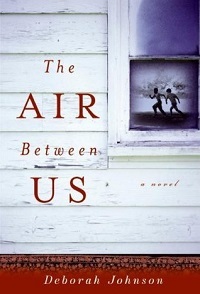 I downloaded a copy of Deborah Johnson’s The Air Between Us after seeing it advertised on Bookperk last week (it’s also on BookBub today). It was first published in 2008, and its themes resound as clearly as ever.
I downloaded a copy of Deborah Johnson’s The Air Between Us after seeing it advertised on Bookperk last week (it’s also on BookBub today). It was first published in 2008, and its themes resound as clearly as ever. Despite the escalating civil rights movement, little has changed over the years in Revere, Mississippi. However, it's 1966, and school integration is on the horizon. Many citizens are staking out their positions, sometimes surprisingly. Dr. Cooper Connelly, a handsome blond doctor with an appropriately elegant socialite wife, comes out in favor of it, which irritates his father, a bigoted state senator.
Racial issues in town get stirred up further when “Critter” Tate, a ten-year-old African-American boy, drives his daddy’s truck up to the whites-only entrance of Doctors Hospital in order to save Billy Ray Puckett, who unintentionally shot himself falling out of a deer stand. Billy Ray was an accident-prone drunk, a poor white man from out in the country, so the incident doesn’t astonish anyone – not right away. Then circumstances persuade the sheriff’s office to investigate his case more deeply.
From this bare-bones plot summary, you’d be tempted to categorize The Air Between Us as a mystery, and it is, in the end – but you’d also be forgiven for getting caught up in the character portrayals and setting genre expectations aside. The focus moves from one fascinating resident of Revere to another with comfortable ease, reminiscent of sitting out on the veranda on a summer evening and hearing a fluent storyteller.
Among the prominent personalities in this tale are the wealthy Dr. Spencer Reese Jackson, who takes pride in being Revere’s only Black doctor; his wife, Deanie, whose self-possessed demeanor masks personal pain; and Miss Melba Obrenski, a light-skinned “Creole card reader” from New Orleans who doesn’t tell anyone, including her next-door neighbor and best friend Deanie, what race she is. Cooper finds that Miss Melba’s a good listener, and with the experience gained in her earlier career, she knows how to handle men – but Cooper seems different. There’s also a hospital administrator, Ned Hampton, “the very embodiment of the whole Mississippi contradiction,” who doesn’t see anything odd about supporting segregation while singing regularly with a Black church choir.
Turns out everyone in Revere has something they choose to keep quiet about, and the story takes its time revealing exactly what that is and why. That’s not to say it’s dull in the least. The multifaceted characters and their concealed back stories lend the story a deep richness. The mysteries wrap up satisfyingly (if a bit too neatly in places), with an underlying message in this absorbing saga: that nobody’s exempt from the responsibility of addressing racial inequities.
The Air Between Us was published in 2008 by Amistad/HarperCollins; in the US, it's currently selling for $1.99 as an ebook.
Published on June 11, 2020 08:07
June 8, 2020
The Lady’s Guide to Celestial Mechanics by Olivia Waite, romance set in the scientific world of Regency England
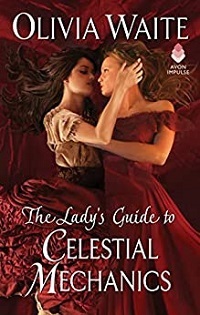 This superb novel, set during Regency times, unveils the love story between two intelligent women who, in different ways, struggle to be taken seriously by the male scientific establishment.
This superb novel, set during Regency times, unveils the love story between two intelligent women who, in different ways, struggle to be taken seriously by the male scientific establishment. In 1812 Lyme, England, Lucy Muchelney is crushed when her lover, Priscilla, weds a man for financial reasons. Lucy had been the uncredited collaborator of her late astronomer father, handling his calculations and correspondence.
When she receives a letter from Catherine St. Day, Countess of Moth, who seeks a translator for a French astronomy masterwork, Lucy, confident in her mathematical and language skills, pays a visit to Lady Moth in London. In the widowed Catherine, a skilled embroiderer whose artistic talents were stifled by her boorish husband, Lucy discovers a benefactor and kindred spirit, but their dissimilar personal histories complicate matters.
Beyond the delicately rendered romance between the more forthright Lucy and Catherine, a gently bred aristocrat, Waite gives full voice to the unfair prejudice that women faced. She also provides a multi-ethnic Regency world that comes alive with scientific curiosity.
Highly recommended for fans of both Remarkable Creatures and Gentleman Jack, this first in the Feminine Pursuits series deserves widespread attention.
The Lady’s Guide to Celestial Mechanics was published by Avon in 2019; I reviewed it from Edelweiss for February's Historical Novels Review. If you're a historical fiction fan looking for a new romance to read for Pride Month this June, it's a good place to start. The author has a second novel in the series, The Care and Feeding of Waspish Widows, out later this summer.
Published on June 08, 2020 03:00
June 5, 2020
The Orphan's Gift by Renita D'Silva, set in India and England across the 20th century
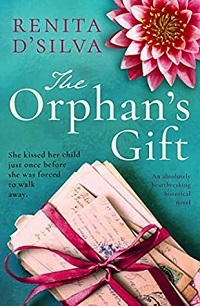 Spanning over 70 years, Renita D’Silva’s newest novel is a touching generational saga about women searching for belonging, falling in love, enduring loss, and learning from past mistakes. Daughter of the deputy commissioner for her region, Alice Harris lives in an elegant compound in the small city of Jamjadpur in early 20th-century India, knowing every material comfort but lacking parental affection. She grows up cocooned in the constant love of her nanny, a local woman she calls Ayah, and Ayah’s son, Raju, who is her playmate and best friend.
Spanning over 70 years, Renita D’Silva’s newest novel is a touching generational saga about women searching for belonging, falling in love, enduring loss, and learning from past mistakes. Daughter of the deputy commissioner for her region, Alice Harris lives in an elegant compound in the small city of Jamjadpur in early 20th-century India, knowing every material comfort but lacking parental affection. She grows up cocooned in the constant love of her nanny, a local woman she calls Ayah, and Ayah’s son, Raju, who is her playmate and best friend.In the 1940s, Janaki is raised by Carmelite nuns in a poor orphanage in the city center. While she dreams of being adopted by kind parents, that chance seems progressively more unlikely over time. Sister Shanthi often tells Janaki the story of how the nuns first found her, a blue-eyed newborn wrapped in a cardigan and left at the gate of St. Ursula’s during the Hindu-Muslim riots of 1936.
The viewpoint alternates between Alice and Janaki, whose connection should be obvious, and the author doesn’t pretend otherwise. Rather, the story follows both girls’ separate journeys and keeps us wondering whether they’ll ever meet.
Some characterizations aren’t subtle: Alice’s cold-hearted father offers statements about India like “They want independence, self-rule, but without us they would not manage at all.” Her mother is a wilting English flower who revives only to party in the cool evenings. More layered is the portrait of blind privilege that D’Silva creates for Alice. As adolescents, she and Raju act on their mutual attraction, sharing a brief kiss, and the repercussions are more dire for him and his family.
With its fast-moving plot and evocation of the sights, scents, and flavors of India, the novel should please fans of commercial women’s fiction and atmospheric settings.
The Orphan's Gift was published by Bookouture in 2020; I reviewed it for the Historical Novels Review in May.
Renita D'Silva, an author from the South of India, has written historical, contemporary, and multi-period novels. Here are links to two others I've reviewed on this site:
A Daughter's Courage , about four women's stories in South India, past and present.
Beneath an Indian Sky , about a childhood friendship between British and Indian girls in the '30s and after.
Published on June 05, 2020 10:27
June 3, 2020
Martha Washington's wedding attire, a guest post by Betty Bolté, author of Becoming Lady Washington
Today I'm welcoming historical novelist Betty Bolté to Reading the Past. Her essay, focused on the attire that Martha Washington wore for her wedding, also delves into fashion trends in the 18th century and how they reflected the wearer's social background and other factors. Hope you'll enjoy reading her post.
~
Martha Washington's Wedding AttireBetty Bolté
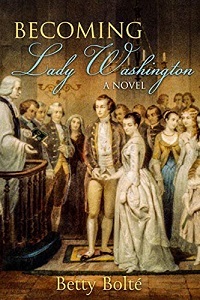 British author L.P. Hartley’s The Go-Between gives us a popular quote: “The past is a foreign country; they do things differently there.” In many ways that is true. On the other hand, there are similarities in those differences. The language of clothing is one of those areas where you can see similar desires and expectations between the 18th century and what we do today. For example, what we wear depends on what we’re going to do (workout at the gym, go to the office, graduate from college, etc.), how much we want to conform to society’s expectations of appropriate attire and modesty, and how much we can afford to spend on our apparel to meet that expectation. The same was true in the past.
British author L.P. Hartley’s The Go-Between gives us a popular quote: “The past is a foreign country; they do things differently there.” In many ways that is true. On the other hand, there are similarities in those differences. The language of clothing is one of those areas where you can see similar desires and expectations between the 18th century and what we do today. For example, what we wear depends on what we’re going to do (workout at the gym, go to the office, graduate from college, etc.), how much we want to conform to society’s expectations of appropriate attire and modesty, and how much we can afford to spend on our apparel to meet that expectation. The same was true in the past.
I’d like for you to consider Martha Washington’s wedding attire as one example, but first let me share some insights into what clothing says about the wearer.
In the 18th century, how you dressed spoke volumes about your status in the community and society. The fashionableness of the style, the quality and hue of the fabric, as well as the wearer’s movements and stance combined to tell others the person’s status, whether high or low or somewhere in between. Keeping up with fashion trends then, as now, meant following the European fashion magazines which were sent to the colonies regularly. Indeed, it’s recorded that Thomas Jefferson sent Parisian fashion magazines to his daughter when he was visiting France.
The style could also indicate, though not always, where the person was from, either by American colony or another country. Clothing suggested the gender and occupation, how rich or poor, and what kind and amount of activity they engaged in. And much like today, what a person wears can also reveal their attitude toward the society they live in. Consider how differently a person would dress if she were a scullery maid versus a personal maid to a planter’s wife versus the planter’s wife, for instance. The same would be true of a field hand versus a dancing tutor versus a lawyer in town.
At the time of Martha and George Washington’s marriage on January 6, 1759, women of a higher status preferred silks brocaded with colorful flowers on a white background. (Brocade is an intricate design on fabric, often raised.) Martha was no exception in preferring silk, especially on her wedding day. Who wouldn’t want the gentle swish and sway of silk, right? Another aspect of choosing her gown is that she would have wanted something she could wear again for other special occasions. They didn’t buy a gown to wear once and put away as a keepsake then. Nor would she have considered a white gown; that fashion came later, in the 19th century.
According to the Mount Vernon historians, Martha’s gown was made of yellow silk damask (meaning reversible) with a petticoat of cream silk highlighted with interwoven silver threads with (perhaps Dresden) lace trim. Her dainty high-heeled shoes were made of purple satin with silver ornamentation. They interpret the message of her outfit as, “The combination of expensive, imported yellow and purple silks with silver and gold decorations would have produced a regal appearance that conveyed her elevated social and economic standing.” You can see a photo of the dress and shoes at the above link. I’ve been to the museum where the outfit is on display and it is far lovelier in person than in the photo. But I do agree with their interpretation.
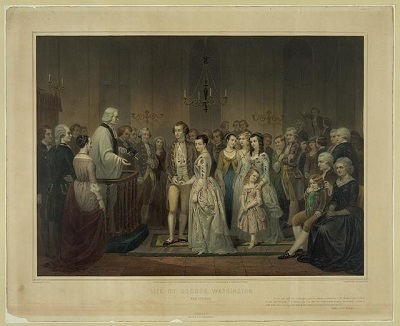
The cover of my historical fiction story of Martha’s life, Becoming Lady Washington, includes an artist’s interpretation of George and Martha’s wedding, an image housed in the Library of Congress. It is not accurate, though, in portraying her attire. In 1759, there were no photographs (obviously) and no sketch artist or portraitist hired to create an image, at least not one that has been found to date. I imagine the man who created the image based it on other similar weddings he’d attended. I particularly enjoy the group of women to the right, apparently oohing and ahhing over the proceedings!
Another portrait in the LOC comes from the C.M. Bell collection, dated between 1873 and 1916, and shows how fashionably dressed Martha was as a young woman. Please note that Martha died in 1802. The LOC dated this image based on the fact that it is contained in Bell’s collection and those were the years he was a photographer. I think he likely took a photo of an earlier oil portrait. You can see in the picture the fine fabric and bows and lace, her posture and hair style all speak to her status. Women wearing such attire would not be working in the kitchen, but have the wealth necessary to support a more leisurely lifestyle.
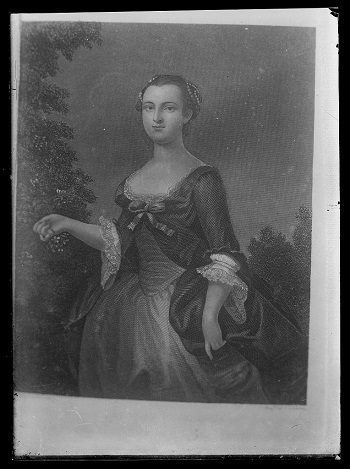
So while the styles and fabrics we wear today have changed, the way we interpret another’s position in society hasn’t changed all that much. We still tend to believe the clothes make the man/woman, that we “dress for success,” or to reveal our rebellion toward societal expectations by wearing clothing others deem in appropriate. I think that attribute of people will likely never change. What do you think about the similarities and differences in interpreting the language of clothing?
~
About Becoming Lady Washington (Published June 2)
Martha “Patsy” Custis manages an immense eighteenth-century plantation in the Virginia colony. But as a young widow she’s hard pressed to balance her business and to care for her two young children. They need a father and protector. She needs a husband and business partner…one she can trust, especially now as tensions rise between the motherland and the American colonies. Her experience and education have sustained her thus far but when her life veers in an unexpected direction, she realizes she has so much more to learn.
Colonel George Washington takes an interest in her and she’s surprised to find him so sociable and appealing. They form an instant bond and she is certain he’ll be a likeable and loving husband and father figure for her children. She envisions a quiet life at Mount Vernon, working together to provide for their extended family.
But when trouble in the form of British oppression, taxes, and royal arrogance leads to revolt and revolution, George must choose between duty to country and Martha. Compelled to take matters into her own hands, Martha must decide whether to remain where she belongs or go with her husband… no matter what the dangerous future may hold.
About the Author
 Award-winning author Betty Bolté is known for authentic and accurately researched American historical fiction with heart and supernatural romance novels. She’s been published in essays, newspaper and magazine articles, and nonfiction books but now enjoys crafting entertaining and informative fiction. She earned a Master’s Degree in English in 2008, emphasizing the study of literature and storytelling, and has judged numerous writing contests for both fiction and nonfiction.
Award-winning author Betty Bolté is known for authentic and accurately researched American historical fiction with heart and supernatural romance novels. She’s been published in essays, newspaper and magazine articles, and nonfiction books but now enjoys crafting entertaining and informative fiction. She earned a Master’s Degree in English in 2008, emphasizing the study of literature and storytelling, and has judged numerous writing contests for both fiction and nonfiction.
She is a member of the Romance Writers of America, Historical Novel Society, Women’s Fiction Writers Association, and Authors Guild. Get to know her at www.bettybolte.com.
~
Martha Washington's Wedding AttireBetty Bolté
 British author L.P. Hartley’s The Go-Between gives us a popular quote: “The past is a foreign country; they do things differently there.” In many ways that is true. On the other hand, there are similarities in those differences. The language of clothing is one of those areas where you can see similar desires and expectations between the 18th century and what we do today. For example, what we wear depends on what we’re going to do (workout at the gym, go to the office, graduate from college, etc.), how much we want to conform to society’s expectations of appropriate attire and modesty, and how much we can afford to spend on our apparel to meet that expectation. The same was true in the past.
British author L.P. Hartley’s The Go-Between gives us a popular quote: “The past is a foreign country; they do things differently there.” In many ways that is true. On the other hand, there are similarities in those differences. The language of clothing is one of those areas where you can see similar desires and expectations between the 18th century and what we do today. For example, what we wear depends on what we’re going to do (workout at the gym, go to the office, graduate from college, etc.), how much we want to conform to society’s expectations of appropriate attire and modesty, and how much we can afford to spend on our apparel to meet that expectation. The same was true in the past.I’d like for you to consider Martha Washington’s wedding attire as one example, but first let me share some insights into what clothing says about the wearer.
In the 18th century, how you dressed spoke volumes about your status in the community and society. The fashionableness of the style, the quality and hue of the fabric, as well as the wearer’s movements and stance combined to tell others the person’s status, whether high or low or somewhere in between. Keeping up with fashion trends then, as now, meant following the European fashion magazines which were sent to the colonies regularly. Indeed, it’s recorded that Thomas Jefferson sent Parisian fashion magazines to his daughter when he was visiting France.
The style could also indicate, though not always, where the person was from, either by American colony or another country. Clothing suggested the gender and occupation, how rich or poor, and what kind and amount of activity they engaged in. And much like today, what a person wears can also reveal their attitude toward the society they live in. Consider how differently a person would dress if she were a scullery maid versus a personal maid to a planter’s wife versus the planter’s wife, for instance. The same would be true of a field hand versus a dancing tutor versus a lawyer in town.
At the time of Martha and George Washington’s marriage on January 6, 1759, women of a higher status preferred silks brocaded with colorful flowers on a white background. (Brocade is an intricate design on fabric, often raised.) Martha was no exception in preferring silk, especially on her wedding day. Who wouldn’t want the gentle swish and sway of silk, right? Another aspect of choosing her gown is that she would have wanted something she could wear again for other special occasions. They didn’t buy a gown to wear once and put away as a keepsake then. Nor would she have considered a white gown; that fashion came later, in the 19th century.
According to the Mount Vernon historians, Martha’s gown was made of yellow silk damask (meaning reversible) with a petticoat of cream silk highlighted with interwoven silver threads with (perhaps Dresden) lace trim. Her dainty high-heeled shoes were made of purple satin with silver ornamentation. They interpret the message of her outfit as, “The combination of expensive, imported yellow and purple silks with silver and gold decorations would have produced a regal appearance that conveyed her elevated social and economic standing.” You can see a photo of the dress and shoes at the above link. I’ve been to the museum where the outfit is on display and it is far lovelier in person than in the photo. But I do agree with their interpretation.

The cover of my historical fiction story of Martha’s life, Becoming Lady Washington, includes an artist’s interpretation of George and Martha’s wedding, an image housed in the Library of Congress. It is not accurate, though, in portraying her attire. In 1759, there were no photographs (obviously) and no sketch artist or portraitist hired to create an image, at least not one that has been found to date. I imagine the man who created the image based it on other similar weddings he’d attended. I particularly enjoy the group of women to the right, apparently oohing and ahhing over the proceedings!
Another portrait in the LOC comes from the C.M. Bell collection, dated between 1873 and 1916, and shows how fashionably dressed Martha was as a young woman. Please note that Martha died in 1802. The LOC dated this image based on the fact that it is contained in Bell’s collection and those were the years he was a photographer. I think he likely took a photo of an earlier oil portrait. You can see in the picture the fine fabric and bows and lace, her posture and hair style all speak to her status. Women wearing such attire would not be working in the kitchen, but have the wealth necessary to support a more leisurely lifestyle.

So while the styles and fabrics we wear today have changed, the way we interpret another’s position in society hasn’t changed all that much. We still tend to believe the clothes make the man/woman, that we “dress for success,” or to reveal our rebellion toward societal expectations by wearing clothing others deem in appropriate. I think that attribute of people will likely never change. What do you think about the similarities and differences in interpreting the language of clothing?
~
About Becoming Lady Washington (Published June 2)
Martha “Patsy” Custis manages an immense eighteenth-century plantation in the Virginia colony. But as a young widow she’s hard pressed to balance her business and to care for her two young children. They need a father and protector. She needs a husband and business partner…one she can trust, especially now as tensions rise between the motherland and the American colonies. Her experience and education have sustained her thus far but when her life veers in an unexpected direction, she realizes she has so much more to learn.
Colonel George Washington takes an interest in her and she’s surprised to find him so sociable and appealing. They form an instant bond and she is certain he’ll be a likeable and loving husband and father figure for her children. She envisions a quiet life at Mount Vernon, working together to provide for their extended family.
But when trouble in the form of British oppression, taxes, and royal arrogance leads to revolt and revolution, George must choose between duty to country and Martha. Compelled to take matters into her own hands, Martha must decide whether to remain where she belongs or go with her husband… no matter what the dangerous future may hold.
About the Author
 Award-winning author Betty Bolté is known for authentic and accurately researched American historical fiction with heart and supernatural romance novels. She’s been published in essays, newspaper and magazine articles, and nonfiction books but now enjoys crafting entertaining and informative fiction. She earned a Master’s Degree in English in 2008, emphasizing the study of literature and storytelling, and has judged numerous writing contests for both fiction and nonfiction.
Award-winning author Betty Bolté is known for authentic and accurately researched American historical fiction with heart and supernatural romance novels. She’s been published in essays, newspaper and magazine articles, and nonfiction books but now enjoys crafting entertaining and informative fiction. She earned a Master’s Degree in English in 2008, emphasizing the study of literature and storytelling, and has judged numerous writing contests for both fiction and nonfiction. She is a member of the Romance Writers of America, Historical Novel Society, Women’s Fiction Writers Association, and Authors Guild. Get to know her at www.bettybolte.com.
Published on June 03, 2020 05:00
Martha Washington's wedding attire, a guest post by Betty Bolté, author of Becoming Lady Washington
Today I'm welcoming historical novelist Betty Bolté to Reading the Past. Her essay, focused on the attire that Martha Washington wore for her wedding, also delves into fashion trends in the 18th century and how they reflected the wearer's social background and other factors. Hope you'll enjoy reading her post.
~
Martha Washington's Wedding AttireBetty Bolté
 British author L.P. Hartley’s The Go-Between gives us a popular quote: “The past is a foreign country; they do things differently there.” In many ways that is true. On the other hand, there are similarities in those differences. The language of clothing is one of those areas where you can see similar desires and expectations between the 18th century and what we do today. For example, what we wear depends on what we’re going to do (workout at the gym, go to the office, graduate from college, etc.), how much we want to conform to society’s expectations of appropriate attire and modesty, and how much we can afford to spend on our apparel to meet that expectation. The same was true in the past.
British author L.P. Hartley’s The Go-Between gives us a popular quote: “The past is a foreign country; they do things differently there.” In many ways that is true. On the other hand, there are similarities in those differences. The language of clothing is one of those areas where you can see similar desires and expectations between the 18th century and what we do today. For example, what we wear depends on what we’re going to do (workout at the gym, go to the office, graduate from college, etc.), how much we want to conform to society’s expectations of appropriate attire and modesty, and how much we can afford to spend on our apparel to meet that expectation. The same was true in the past.
I’d like for you to consider Martha Washington’s wedding attire as one example, but first let me share some insights into what clothing says about the wearer.
In the 18th century, how you dressed spoke volumes about your status in the community and society. The fashionableness of the style, the quality and hue of the fabric, as well as the wearer’s movements and stance combined to tell others the person’s status, whether high or low or somewhere in between. Keeping up with fashion trends then, as now, meant following the European fashion magazines which were sent to the colonies regularly. Indeed, it’s recorded that Thomas Jefferson sent Parisian fashion magazines to his daughter when he was visiting France.
The style could also indicate, though not always, where the person was from, either by American colony or another country. Clothing suggested the gender and occupation, how rich or poor, and what kind and amount of activity they engaged in. And much like today, what a person wears can also reveal their attitude toward the society they live in. Consider how differently a person would dress if she were a scullery maid versus a personal maid to a planter’s wife versus the planter’s wife, for instance. The same would be true of a field hand versus a dancing tutor versus a lawyer in town.
At the time of Martha and George Washington’s marriage on January 6, 1759, women of a higher status preferred silks brocaded with colorful flowers on a white background. (Brocade is an intricate design on fabric, often raised.) Martha was no exception in preferring silk, especially on her wedding day. Who wouldn’t want the gentle swish and sway of silk, right? Another aspect of choosing her gown is that she would have wanted something she could wear again for other special occasions. They didn’t buy a gown to wear once and put away as a keepsake then. Nor would she have considered a white gown; that fashion came later, in the 19th century.
According to the Mount Vernon historians, Martha’s gown was made of yellow silk damask (meaning reversible) with a petticoat of cream silk highlighted with interwoven silver threads with (perhaps Dresden) lace trim. Her dainty high-heeled shoes were made of purple satin with silver ornamentation. They interpret the message of her outfit as, “The combination of expensive, imported yellow and purple silks with silver and gold decorations would have produced a regal appearance that conveyed her elevated social and economic standing.” You can see a photo of the dress and shoes at the above link. I’ve been to the museum where the outfit is on display and it is far lovelier in person than in the photo. But I do agree with their interpretation.

The cover of my historical fiction story of Martha’s life, Becoming Lady Washington, includes an artist’s interpretation of George and Martha’s wedding, an image housed in the Library of Congress. It is not accurate, though, in portraying her attire. In 1759, there were no photographs (obviously) and no sketch artist or portraitist hired to create an image, at least not one that has been found to date. I imagine the man who created the image based it on other similar weddings he’d attended. I particularly enjoy the group of women to the right, apparently oohing and ahhing over the proceedings!
Another portrait in the LOC comes from the C.M. Bell collection, dated between 1873 and 1916, and shows how fashionably dressed Martha was as a young woman. Please note that Martha died in 1802. The LOC dated this image based on the fact that it is contained in Bell’s collection and those were the years he was a photographer. I think he likely took a photo of an earlier oil portrait. You can see in the picture the fine fabric and bows and lace, her posture and hair style all speak to her status. Women wearing such attire would not be working in the kitchen, but have the wealth necessary to support a more leisurely lifestyle.

So while the styles and fabrics we wear today have changed, the way we interpret another’s position in society hasn’t changed all that much. We still tend to believe the clothes make the man/woman, that we “dress for success,” or to reveal our rebellion toward societal expectations by wearing clothing others deem in appropriate. I think that attribute of people will likely never change. What do you think about the similarities and differences in interpreting the language of clothing?
~
About Becoming Lady Washington (Published June 2)
Martha “Patsy” Custis manages an immense eighteenth-century plantation in the Virginia colony. But as a young widow she’s hard pressed to balance her business and to care for her two young children. They need a father and protector. She needs a husband and business partner…one she can trust, especially now as tensions rise between the motherland and the American colonies. Her experience and education have sustained her thus far but when her life veers in an unexpected direction, she realizes she has so much more to learn.
Colonel George Washington takes an interest in her and she’s surprised to find him so sociable and appealing. They form an instant bond and she is certain he’ll be a likeable and loving husband and father figure for her children. She envisions a quiet life at Mount Vernon, working together to provide for their extended family.
But when trouble in the form of British oppression, taxes, and royal arrogance leads to revolt and revolution, George must choose between duty to country and Martha. Compelled to take matters into her own hands, Martha must decide whether to remain where she belongs or go with her husband… no matter what the dangerous future may hold.
About the Author
 Award-winning author Betty Bolté is known for authentic and accurately researched American historical fiction with heart and supernatural romance novels. She’s been published in essays, newspaper and magazine articles, and nonfiction books but now enjoys crafting entertaining and informative fiction. She earned a Master’s Degree in English in 2008, emphasizing the study of literature and storytelling, and has judged numerous writing contests for both fiction and nonfiction.
Award-winning author Betty Bolté is known for authentic and accurately researched American historical fiction with heart and supernatural romance novels. She’s been published in essays, newspaper and magazine articles, and nonfiction books but now enjoys crafting entertaining and informative fiction. She earned a Master’s Degree in English in 2008, emphasizing the study of literature and storytelling, and has judged numerous writing contests for both fiction and nonfiction.
She is a member of the Romance Writers of America, Historical Novel Society, Women’s Fiction Writers Association, and Authors Guild. Get to know her at www.bettybolte.com.
~
Martha Washington's Wedding AttireBetty Bolté
 British author L.P. Hartley’s The Go-Between gives us a popular quote: “The past is a foreign country; they do things differently there.” In many ways that is true. On the other hand, there are similarities in those differences. The language of clothing is one of those areas where you can see similar desires and expectations between the 18th century and what we do today. For example, what we wear depends on what we’re going to do (workout at the gym, go to the office, graduate from college, etc.), how much we want to conform to society’s expectations of appropriate attire and modesty, and how much we can afford to spend on our apparel to meet that expectation. The same was true in the past.
British author L.P. Hartley’s The Go-Between gives us a popular quote: “The past is a foreign country; they do things differently there.” In many ways that is true. On the other hand, there are similarities in those differences. The language of clothing is one of those areas where you can see similar desires and expectations between the 18th century and what we do today. For example, what we wear depends on what we’re going to do (workout at the gym, go to the office, graduate from college, etc.), how much we want to conform to society’s expectations of appropriate attire and modesty, and how much we can afford to spend on our apparel to meet that expectation. The same was true in the past.I’d like for you to consider Martha Washington’s wedding attire as one example, but first let me share some insights into what clothing says about the wearer.
In the 18th century, how you dressed spoke volumes about your status in the community and society. The fashionableness of the style, the quality and hue of the fabric, as well as the wearer’s movements and stance combined to tell others the person’s status, whether high or low or somewhere in between. Keeping up with fashion trends then, as now, meant following the European fashion magazines which were sent to the colonies regularly. Indeed, it’s recorded that Thomas Jefferson sent Parisian fashion magazines to his daughter when he was visiting France.
The style could also indicate, though not always, where the person was from, either by American colony or another country. Clothing suggested the gender and occupation, how rich or poor, and what kind and amount of activity they engaged in. And much like today, what a person wears can also reveal their attitude toward the society they live in. Consider how differently a person would dress if she were a scullery maid versus a personal maid to a planter’s wife versus the planter’s wife, for instance. The same would be true of a field hand versus a dancing tutor versus a lawyer in town.
At the time of Martha and George Washington’s marriage on January 6, 1759, women of a higher status preferred silks brocaded with colorful flowers on a white background. (Brocade is an intricate design on fabric, often raised.) Martha was no exception in preferring silk, especially on her wedding day. Who wouldn’t want the gentle swish and sway of silk, right? Another aspect of choosing her gown is that she would have wanted something she could wear again for other special occasions. They didn’t buy a gown to wear once and put away as a keepsake then. Nor would she have considered a white gown; that fashion came later, in the 19th century.
According to the Mount Vernon historians, Martha’s gown was made of yellow silk damask (meaning reversible) with a petticoat of cream silk highlighted with interwoven silver threads with (perhaps Dresden) lace trim. Her dainty high-heeled shoes were made of purple satin with silver ornamentation. They interpret the message of her outfit as, “The combination of expensive, imported yellow and purple silks with silver and gold decorations would have produced a regal appearance that conveyed her elevated social and economic standing.” You can see a photo of the dress and shoes at the above link. I’ve been to the museum where the outfit is on display and it is far lovelier in person than in the photo. But I do agree with their interpretation.

The cover of my historical fiction story of Martha’s life, Becoming Lady Washington, includes an artist’s interpretation of George and Martha’s wedding, an image housed in the Library of Congress. It is not accurate, though, in portraying her attire. In 1759, there were no photographs (obviously) and no sketch artist or portraitist hired to create an image, at least not one that has been found to date. I imagine the man who created the image based it on other similar weddings he’d attended. I particularly enjoy the group of women to the right, apparently oohing and ahhing over the proceedings!
Another portrait in the LOC comes from the C.M. Bell collection, dated between 1873 and 1916, and shows how fashionably dressed Martha was as a young woman. Please note that Martha died in 1802. The LOC dated this image based on the fact that it is contained in Bell’s collection and those were the years he was a photographer. I think he likely took a photo of an earlier oil portrait. You can see in the picture the fine fabric and bows and lace, her posture and hair style all speak to her status. Women wearing such attire would not be working in the kitchen, but have the wealth necessary to support a more leisurely lifestyle.

So while the styles and fabrics we wear today have changed, the way we interpret another’s position in society hasn’t changed all that much. We still tend to believe the clothes make the man/woman, that we “dress for success,” or to reveal our rebellion toward societal expectations by wearing clothing others deem in appropriate. I think that attribute of people will likely never change. What do you think about the similarities and differences in interpreting the language of clothing?
~
About Becoming Lady Washington (Published June 2)
Martha “Patsy” Custis manages an immense eighteenth-century plantation in the Virginia colony. But as a young widow she’s hard pressed to balance her business and to care for her two young children. They need a father and protector. She needs a husband and business partner…one she can trust, especially now as tensions rise between the motherland and the American colonies. Her experience and education have sustained her thus far but when her life veers in an unexpected direction, she realizes she has so much more to learn.
Colonel George Washington takes an interest in her and she’s surprised to find him so sociable and appealing. They form an instant bond and she is certain he’ll be a likeable and loving husband and father figure for her children. She envisions a quiet life at Mount Vernon, working together to provide for their extended family.
But when trouble in the form of British oppression, taxes, and royal arrogance leads to revolt and revolution, George must choose between duty to country and Martha. Compelled to take matters into her own hands, Martha must decide whether to remain where she belongs or go with her husband… no matter what the dangerous future may hold.
About the Author
 Award-winning author Betty Bolté is known for authentic and accurately researched American historical fiction with heart and supernatural romance novels. She’s been published in essays, newspaper and magazine articles, and nonfiction books but now enjoys crafting entertaining and informative fiction. She earned a Master’s Degree in English in 2008, emphasizing the study of literature and storytelling, and has judged numerous writing contests for both fiction and nonfiction.
Award-winning author Betty Bolté is known for authentic and accurately researched American historical fiction with heart and supernatural romance novels. She’s been published in essays, newspaper and magazine articles, and nonfiction books but now enjoys crafting entertaining and informative fiction. She earned a Master’s Degree in English in 2008, emphasizing the study of literature and storytelling, and has judged numerous writing contests for both fiction and nonfiction. She is a member of the Romance Writers of America, Historical Novel Society, Women’s Fiction Writers Association, and Authors Guild. Get to know her at www.bettybolte.com.
Published on June 03, 2020 05:00
May 30, 2020
Katheryn Howard, The Scandalous Queen by Alison Weir depicts a sad episode in Tudor history
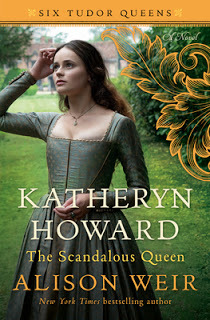 Katheryn Howard, Henry VIII’s “rose without a thorn,” not only deceived the king about her previous lovers but dallied with another man during their marriage. What on earth was she thinking?
Katheryn Howard, Henry VIII’s “rose without a thorn,” not only deceived the king about her previous lovers but dallied with another man during their marriage. What on earth was she thinking? In the fifth novel in her Six Tudor Queens series, Weir convincingly imagines the answer to that question. Incorporating period sources about Katheryn (which weave smoothly into the narrative), she plunges readers into the viewpoint of a fun-loving, naive young woman whose unorthodox upbringing and poor choices precipitated her downfall.
Raised by caring relatives after her mother’s death, the attractive, dowerless Katheryn later enters the lax household of her step-grandmother, the Dowager Duchess of Norfolk, and falls in with a sexually adventurous crowd. After her ambitious Catholic uncle pushes her toward King Henry VIII, she decides becoming queen has definite appeal and develops affection for her aging, devoted royal husband.
Her past, however, leaves her vulnerable to blackmail, and it’s fascinating and disquieting to see how she justifies her decisions. Though Katheryn lacks the intellectual depth of Weir’s previous heroines, her character portrait is similarly astute.
Katheryn Howard, The Scandalous Queen was published this month by Ballantine in hardcover and ebook. In the UK, the title is Katheryn Howard, The Tainted Queen. I reviewed it for the 4/15 issue of Booklist (reprinted with permission) and am looking forward to Katharine Parr, The Sixth Wife, next year.
Other notes: I did wonder, after reading the previous books in the series, what Weir would make of Katheryn Howard. Her life was shorter than that of her predecessors, and there just didn't seem to be as much substance to work with. With her own first cousin (Anne Boleyn) having been charged with adultery and beheaded, Katheryn could have remained faithful and enjoyed her royal position while it lasted, since she was decades younger than Henry and would likely outlive him. But that's not what happened. Put plainly, she didn't seem especially bright. Weir's novel didn't convince me otherwise, but she did a great job with the historical material and explained why Katheryn behaved as she did. As such, I found this novel particularly successful as an example of biographical fiction.
Published on May 30, 2020 08:14
May 25, 2020
Africaville by Jeffrey Colvin tells a generational story anchored in Black Canadian history
 Colvin’s debut novel, a literary saga spanning over seventy years, is as much about the legacy of a place as the place itself.
Colvin’s debut novel, a literary saga spanning over seventy years, is as much about the legacy of a place as the place itself.The story follows the lives of three generations of Black Canadians. Kath Ella Sebolt, a young woman during the Depression, leaves her home behind for a career in Montreal; her son, Omar/Etienne, distances himself further from his origins, passing as a white man in the Deep South; and his son, Warner, makes astonishing discoveries about his ancestry and reaches out to reconnect with it. In addition to their familial ties, linking them together is a shared heritage in – and estrangement from – Woods Bluff, a Black neighborhood of Halifax, Nova Scotia.
Little by little, Colvin intertwines his characters’ experiences with details of his setting’s unique history (which is based on the real-life village of Africville), beginning with its original settlement by formerly enslaved Jamaicans and Americans in the late 18th century. The novel delves into the close-knit society of Woods Bluff’s many residents, focusing on their day-to-day concerns, including moments of rebellion and friendship, deeply felt tragedies, and their relationships with their skin color. They are all affected, in one or more ways, by prejudice and unequal treatment from the government. Despite this neglect and some internal strife, the neighborhood thrives as a close-knit community for over a century.
At first, the unadorned sentences left me observing the people from a close distance rather than drawn into their lives and emotions, but partway through, this opaqueness began to break down, and the storytelling flowed more easily. Colvin refuses to pass judgment on the characters’ decisions and simply presents them as they are, with their own personalities, flaws, and strengths. It’s a worthy story of perseverance that succeeds in illuminating a little-known slice of North American history.
Africaville was published by Amistad, an imprint of HarperCollins, in December 2019; I reviewed it from Edelweiss for May's Historical Novels Review.
Published on May 25, 2020 12:33
May 21, 2020
Imogen Kealey's Liberation, an action-adventure thriller featuring WWII heroine Nancy Wake
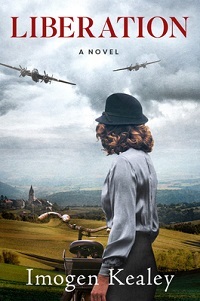 Nancy Wake, the WWII resistance heroine who died in 2011, age 98, has been having a moment. Satisfying readers’ hunger for fiction about real-life women from the 20th century, several novelists have been inspired by her daring accomplishments, including Ariel Lawhon (Code Name Hélène). Now Imogen Kealey offers their own version in the novel Liberation.
Nancy Wake, the WWII resistance heroine who died in 2011, age 98, has been having a moment. Satisfying readers’ hunger for fiction about real-life women from the 20th century, several novelists have been inspired by her daring accomplishments, including Ariel Lawhon (Code Name Hélène). Now Imogen Kealey offers their own version in the novel Liberation. Wake was made of stronger fiber than most of us. After witnessing atrocities in Vienna in the ‘30s, she determined to do her utmost to obliterate the Nazi regime. As an agent with Britain’s SOE (Special Operations Executive) operating in the Auvergne region of central France, she organized and trained local resistance fighters (maquisards): arming them, arranging for supply drops from Britain alongside wireless operator Denis Rake, and disrupting the German supply lines in advance of D-Day. Following the war, she received multiple honors from the UK and France as well as from Australia, her adopted country, and New Zealand, where she was born.
“Imogen Kealey” is the pseudonym for Hollywood screenwriter Darby Kealey and British novelist Imogen Robertson, and their jointly written novel is unabashedly a thriller; its fast-paced, suspenseful scenes should fulfill anyone’s desire for an adrenaline rush. It opens in 1943 as Nancy, concealing herself amid the rubble of destroyed buildings in Marseille’s Old Quarter, narrowly escapes the German patrol, who don’t realize that one of their prime targets – the so-called “White Mouse,” Nancy herself – is nearby. Following this close call, she returns home to prepare for her wedding to rich industrialist Henri Fiocca. Later, needing to leave France quickly, she valiantly pursues her mission to fight against Nazi dominance all the while knowing she’s left her beloved husband in danger.
Many episodes taken from Nancy’s return to France as an agent are excitingly described in the novel’s pages, from her ongoing difficulties in convincing the maquisard leader, Gaspard, that she, a woman, deserves to be in charge; to her awe-inspiring bicycle ride, traveling 500km in three days to locate a radio operator for re-establishing contact with Britain for future supply drops.
That said, the fictional liberties taken in Liberation are numerous and explained over three pages in the author’s note. For example, by 1943, Nanci and Henri had already been married for several years. Many other aspects of the timeline are rearranged for dramatic purposes, and one critical member of her three-person team, agent John Hind Farmer (“Hubert”), is omitted. While Nancy shows vulnerability in her constant worry about her husband’s safety, and she’s internally tough and fond of swearing, as she was in life, there’s little evidence of the “irrepressible, infectious, high spirits [that] were a joy to everyone who worked with her,” as recounted by the SOE’s official historian. Her cover name of “Madame Andree” isn’t used; puzzlingly, Nancy gives out her real name freely throughout her covert resistance activities.
While this story may appeal to readers wanting a suspenseful action-adventure novel, those interested in the historical Nancy Wake should pay close attention to the author’s note and follow up with their own research (there’s a forthcoming movie based on this book, too). For fiction readers seeking more nuanced character depictions and stronger adherence to biographical details, Code Name Hélène will be a better option.
Liberation was published on April 28 by Grand Central; thanks to the publisher for the review copy.
Published on May 21, 2020 05:00
May 19, 2020
Research in Nebraska's Legacy of the Plains Museum for Answer Creek, an essay by Ashley E. Sweeney
Research in museums and archives can reveal important details for historical novelists. Contributing an essay on this topic is author Ashley Sweeney, whose second novel, Answer Creek, is published by She Writes Press today.
~
Research in Nebraska's Legacy of the Plains Museum for Answer CreekAshley E. Sweeney
On a broad swath of prairie grassland just outside Scott’s Bluff, Nebraska, there’s a little-known gem of a place that’s a veritable mother lode for western memorabilia and research.
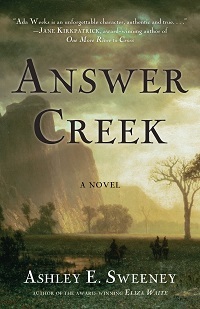 The Legacy of the Plains Museum in Gering, Nebraska houses The Paul and Helen Henderson Collection, an amazing compilation of the Hendersons' 50 years documenting the Oregon Trail. In addition to 100 boxes filled with slides, maps, photographs, manuscripts, pioneer diaries, guides, and letters spanning the 19th century, the collection also includes notes, correspondence, maps, diagrams, and photographs from the Hendersons themselves.
The Legacy of the Plains Museum in Gering, Nebraska houses The Paul and Helen Henderson Collection, an amazing compilation of the Hendersons' 50 years documenting the Oregon Trail. In addition to 100 boxes filled with slides, maps, photographs, manuscripts, pioneer diaries, guides, and letters spanning the 19th century, the collection also includes notes, correspondence, maps, diagrams, and photographs from the Hendersons themselves.
As I was traveling the length of the Oregon-California Trail doing research for Answer Creek, I made an appointment at the museum to check out their collection. My parameters: reading original journals and diaries from 1845-1859. Little did I know that what might have taken a couple of hours turned into an entire day! So it was, for more than six hours on a sweltering day in mid-July 2018, I spread out the contents of seven boxes of material in the museum’s conference room and raced the clock to copy, photograph (with permission), and cite document after document. Hour turned to hour and I didn’t even have time—or the inclination—to take a break.
Thursday, June 12 1845
The weather being extremely hot, and there being not a single drop of water to be obtained before we got to the gorge, we suffered a great deal from the thirst, as did our poor animals . . .
—J. Henry Carleton
April 23 1847
Made 19 miles; traveled until dark. Ate a cold bite and went to bed chilly and cold, which is very disagreeable with a parcel of little children . . .
—Elizabeth Dixon Smith Geer
June 29th 1847
To day our cattle complained; much of the dust is very bad. The road to day is very uneven, and winds amongst the Black Hills. The emigrants now begin to see that they have loaded too heavy . . .
—Chester Ingersoll
Thursday, May 26th 1859
Rather cold. Continued our journey up the South Side of the South Platte. We haven’t anything to lose by going, and nothing to make by going back . . .
—J. A. Wilkinson
Quite a bit of the information I gleaned from my day at Legacy of the Plains found its way into Answer Creek. My favorite was a passage where the journal writer describes emigrants “swilling rot-gut whiskey for spiritual consolation.” Through the words of tired and dust-covered overland pioneers, I could almost taste it.
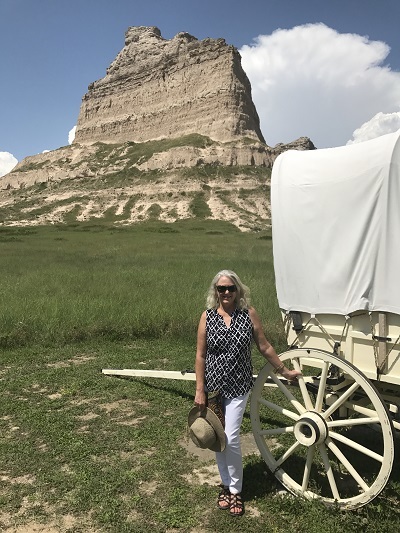
All the while, my husband (and usual research assistant), toured the museum, videotaped an authentic threshing bee on the museum grounds, and shot the breeze with some older locals. Michael spent his summers as a child in nearby Bayard, Nebraska on his great aunt and uncle’s farm so there’s a deep connection for him in that particular part of the world.
I was also particularly taken with western Nebraska—its wide skies, unusual monoliths, and amazing cloud formations. At the top of Scott’s Bluff National Monument, you can almost touch the sky. And then we bedded down at a bed and breakfast that rivals any we’ve ever stayed at, with each guest room appointed with authentic trail memorabilia and antiques. And the hospitality! As a native New Yorker, I’d never given Nebraska the time of day before then. Not anymore.
http://legacyoftheplains.org/
https://www.nps.gov/scbl/index.htm
http://barnanew.com/
~
About Answer Creek: Shaped by Sweeney’s thorough research and vivid prose, this memorable and moving novel of the Donner Party rises above the scandalous to deliver a compassionate portrayal of families pushed to the edge of their humanity and of a determined young woman carving her own path toward love and independence.
Award-winning author Ashley E. Sweeney received the 2017 Nancy Pearl Book Award for her debut novel, Eliza Waite. Sweeney is a former journalist and educator. A native New Yorker, she now divides her time between the Pacific Northwest and Tucson, Arizona. Answer Creek (She Writes Press, May 2020) is her second novel. Find her online at ashleyesweeneyauthor.com, @ashleysweeney57, facebook.com/ashleysweeney57, and Instagram at ashleysweeney57.
~
Research in Nebraska's Legacy of the Plains Museum for Answer CreekAshley E. Sweeney
On a broad swath of prairie grassland just outside Scott’s Bluff, Nebraska, there’s a little-known gem of a place that’s a veritable mother lode for western memorabilia and research.
 The Legacy of the Plains Museum in Gering, Nebraska houses The Paul and Helen Henderson Collection, an amazing compilation of the Hendersons' 50 years documenting the Oregon Trail. In addition to 100 boxes filled with slides, maps, photographs, manuscripts, pioneer diaries, guides, and letters spanning the 19th century, the collection also includes notes, correspondence, maps, diagrams, and photographs from the Hendersons themselves.
The Legacy of the Plains Museum in Gering, Nebraska houses The Paul and Helen Henderson Collection, an amazing compilation of the Hendersons' 50 years documenting the Oregon Trail. In addition to 100 boxes filled with slides, maps, photographs, manuscripts, pioneer diaries, guides, and letters spanning the 19th century, the collection also includes notes, correspondence, maps, diagrams, and photographs from the Hendersons themselves. As I was traveling the length of the Oregon-California Trail doing research for Answer Creek, I made an appointment at the museum to check out their collection. My parameters: reading original journals and diaries from 1845-1859. Little did I know that what might have taken a couple of hours turned into an entire day! So it was, for more than six hours on a sweltering day in mid-July 2018, I spread out the contents of seven boxes of material in the museum’s conference room and raced the clock to copy, photograph (with permission), and cite document after document. Hour turned to hour and I didn’t even have time—or the inclination—to take a break.
Thursday, June 12 1845
The weather being extremely hot, and there being not a single drop of water to be obtained before we got to the gorge, we suffered a great deal from the thirst, as did our poor animals . . .
—J. Henry Carleton
April 23 1847
Made 19 miles; traveled until dark. Ate a cold bite and went to bed chilly and cold, which is very disagreeable with a parcel of little children . . .
—Elizabeth Dixon Smith Geer
June 29th 1847
To day our cattle complained; much of the dust is very bad. The road to day is very uneven, and winds amongst the Black Hills. The emigrants now begin to see that they have loaded too heavy . . .
—Chester Ingersoll
Thursday, May 26th 1859
Rather cold. Continued our journey up the South Side of the South Platte. We haven’t anything to lose by going, and nothing to make by going back . . .
—J. A. Wilkinson
Quite a bit of the information I gleaned from my day at Legacy of the Plains found its way into Answer Creek. My favorite was a passage where the journal writer describes emigrants “swilling rot-gut whiskey for spiritual consolation.” Through the words of tired and dust-covered overland pioneers, I could almost taste it.

All the while, my husband (and usual research assistant), toured the museum, videotaped an authentic threshing bee on the museum grounds, and shot the breeze with some older locals. Michael spent his summers as a child in nearby Bayard, Nebraska on his great aunt and uncle’s farm so there’s a deep connection for him in that particular part of the world.
I was also particularly taken with western Nebraska—its wide skies, unusual monoliths, and amazing cloud formations. At the top of Scott’s Bluff National Monument, you can almost touch the sky. And then we bedded down at a bed and breakfast that rivals any we’ve ever stayed at, with each guest room appointed with authentic trail memorabilia and antiques. And the hospitality! As a native New Yorker, I’d never given Nebraska the time of day before then. Not anymore.
http://legacyoftheplains.org/
https://www.nps.gov/scbl/index.htm
http://barnanew.com/
~
About Answer Creek: Shaped by Sweeney’s thorough research and vivid prose, this memorable and moving novel of the Donner Party rises above the scandalous to deliver a compassionate portrayal of families pushed to the edge of their humanity and of a determined young woman carving her own path toward love and independence.
Award-winning author Ashley E. Sweeney received the 2017 Nancy Pearl Book Award for her debut novel, Eliza Waite. Sweeney is a former journalist and educator. A native New Yorker, she now divides her time between the Pacific Northwest and Tucson, Arizona. Answer Creek (She Writes Press, May 2020) is her second novel. Find her online at ashleyesweeneyauthor.com, @ashleysweeney57, facebook.com/ashleysweeney57, and Instagram at ashleysweeney57.
Published on May 19, 2020 05:00
May 14, 2020
The Course of All Treasons by Suzanne M. Wolfe continues an entertaining Elizabethan espionage series
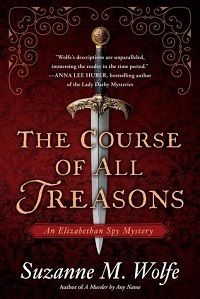 In his second entertaining outing, the Honorable Nicholas “Nick” Holt confronts a twisted web of peril in 1586 England and gets caught in the thick of it.
In his second entertaining outing, the Honorable Nicholas “Nick” Holt confronts a twisted web of peril in 1586 England and gets caught in the thick of it. Novels about Elizabethan-era espionage often delve into threats against England from Catholic Spain and Her Majesty’s sister-monarch to the north, Mary Queen of Scots. Suzanne M. Wolfe spices up the brew by incorporating rival English spy networks and an exiled Irish noblewoman from a powerful, embattled clan.
After his recent success in finding the killer of royal ladies-in-waiting, Nick is asked by Sir Francis Walsingham, Queen Elizabeth’s spymaster, to find out who murdered a fellow agent and dropped his body in the Thames. A Spanish diplomat appears to be linked to the crime, and events transpire that make it seem like other agents are being targeted.
Amidst all the plotting and counter-plotting, Nick gets stuck with the company of Edmund Lovett, an overly-eager-to-please former Oxford schoolmate who saves his life on the road. Edmund works for the Earl of Essex, a foppish high-ranking aristocrat who’s set up his own team of spies. With both Essex and Walsingham serving Elizabeth, one hopes they’d be on the same side, but the competition between them means that’s only partly true.
This is a series where you’ll arrive for the intrigue and period atmosphere and stay for the multifaceted characters. The author knows her way around Tudor London, from a muddy riverside wharf to the inner sanctum of Sir Robert Cecil, Walsingham’s redoubtable young future successor. Almost everyone near the royal court has secrets, including Nick, younger brother of the Earl of Blackwell, who keeps his identity as a spy (and his family’s Catholic past) closely hidden. Even Essex has more depth than it initially seems, and then there’s Lady Annie O’Neill, a tall, dangerous redhead with hidden talents.
While Nick’s relationship with Kat, madam of a Bankside brothel, remains strong, this novel sees him getting more serious about Rivkah, a young doctor working alongside her twin brother. He admires her forthrightness and dislikes having to keep his status as an agent from her. Reading the first book (A Murder By Any Name) isn’t needed to appreciate this one, and if you haven’t yet, there aren’t any spoilers here. Both are definitely recommended.
The Course of All Treasons was published by Crooked Lane in March; thanks to the author and publisher for the review copy.
Published on May 14, 2020 07:50



